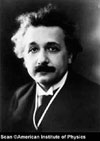|
|
Achievements

-
Einstein showed that absolute time had to be replaced by a new absolute: the speed of light. Einstein went against the grain and totally dismissed the "Old Physics." He envisioned a world where space and time are relative and the speed of light is absolute (at the time, it was believed that space and time were absolute and the speed of light was relative).
-
He asserted the equivalence of mass and energy, which would lead to the famous formula E=mc2
Einstein challenged the wave theory of light, suggesting that light could also be regarded as a collection of particles. This helped to open the door to a whole new world--that of quantum physics. For ideas in this paper, he won the Nobel Prize in 1921.
- His paper concerning the Brownian motion of particles. With profound insight, Einstein blended ideas from kinetic theory and classical hydrodynamics to derive an equation for the mean free path of such particles as a function of the time.
- Einstein showed how to calculate Avogadro's number and the size of molecules.
-
In 1910, Einstein answered a basic question: 'Why is the sky blue?' His paper on the phenomenon called critical opalescence solved the problem by examining the cumulative effect of the scattering of light by individual molecules in the atmosphere.
-
Einstein later published a paper in 1915 called "General Relativity." General Relativity took over when Special Relativity started to fail. Controversy started to rise when Einstein released his second paper called "General Relativity."
-
In 1917, Einstein
published
a paper which uses general relativity to model the behavior of an entire universe. General relativity has spawned some of the weirdest, and most important results in modern astronomy.
-
Einstein
recognized
that there might be a problem with the classical notion of cause and effect. Given the peculiar, dual nature of quanta as both waves and particles, it might be impossible, he warns, to definitively tie effects to their causes.
-
Between 1905 and 1925, Einstein transformed humankind's understanding of nature on every scale, from the smallest to that of the cosmos as a whole. Now, nearly a century after he began to make his mark, we are still exploring Einstein's universe.
-
In 1924, Einstein received a short paper from a young Indian physicist named Satyendra Nath Bose, describing light as a gas of photons, and asking for Einstein's assistance in publication. Einstein realised that the same statistics could be applied to atoms, and published an article in German (then the lingua franca of physics) which described Bose's model and explained its implications. Bose Einstein statistics now describes any assembly of these indistinguishable particles known as bosons.

-
Einstein and de Sitter in 1932 proposed a simple solution of the field equations of general relativity for an expanding universe. They argued that there might be large amounts of matter which does not emit light and has not been detected. This matter, now called 'dark matter', has since been shown to exist by observing is gravitational effects.
|
|
| |
|
|